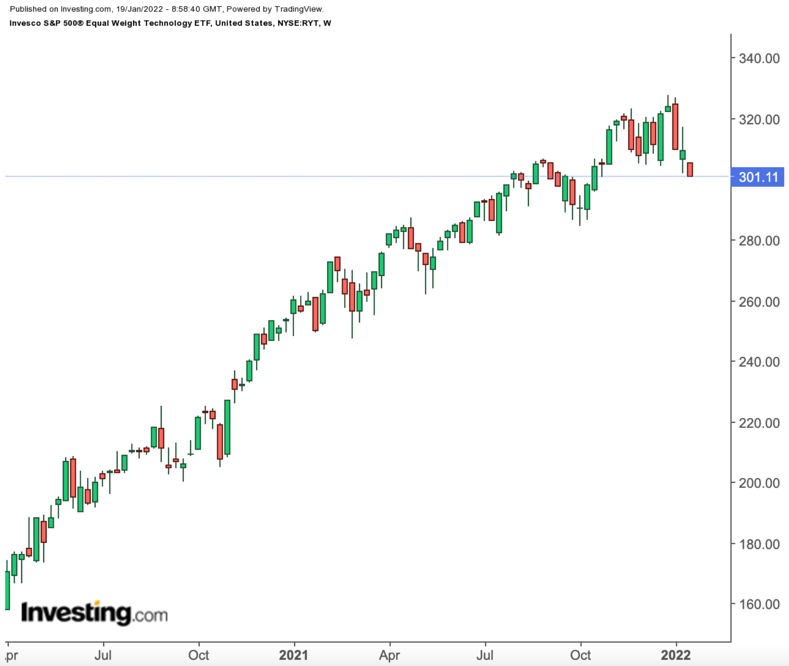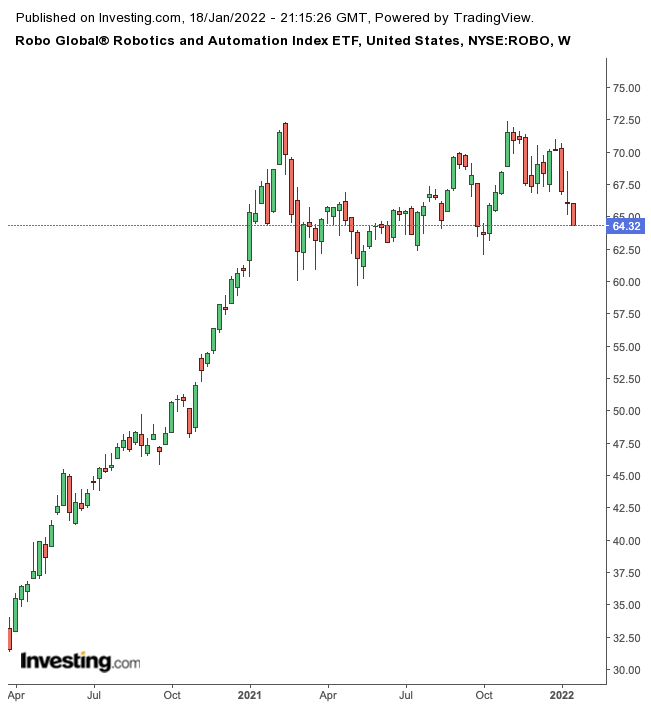Berkshire Hathaway reveals $4.3 billion stake in Alphabet, cuts Apple
Tech shares have mostly begun 2022 on a down note, as the tech-heavy NASDAQ 100 index has lost 5% since the start of the year. Seasoned investors realize that occasional market declines, especially around earnings release dates, can offer reasonable entry points into robust shares and exchange-traded funds (ETFs) that invest in them.
In the past decade, buying quality tech shares has meant significant portfolio returns for long-term investors. A recent JPMorgan Chase report highlights that the sector accounts for 28% of market capitalization in the US. The investment bank expects technology and health care sectors to “generate most of the transformation and growth headlines” in 2022.
Today’s article introduces two ETFs that could appeal to readers who want to include tech shares in their portfolios.
1. Invesco S&P 500 Equal Weight Technology ETF
- Current Price: $301.11
- 52-Week Range: $247.33 - $327.81
- Dividend Yield: 0.41%
- Expense Ratio: 0.40% per year
We recently discussed why investing in equally-weighted ETFs could help offset volatility during a busy earnings season. Our first fund, the Invesco S&P 500® Equal Weight Technology ETF (NYSE:RYT), gives access to the information technology sector of the S&P 500 Index. This equally-weighted fund started trading in November 2006.
RYT, which has 78 stocks, tracks the S&P 500 Equal Weight Information Technology Index. The top 10 holdings account for about 15% of net assets of $2.81 billion.
In terms of sub-sectors, the fund is divided in semiconductors & semiconductor equipment (26.16%), IT services (25.96%), software (20.80%), and electronic equipment, instruments & components (11.55%).
Global Payments (NYSE:GPN), which provides payment technology services; Software-as-a-Service (SaaS) name Citrix Systems (NASDAQ:CTXS), which offers workplace solutions; enterprise tech company Hewlett Packard Enterprises (NYSE:HPE); Western Digital (NASDAQ:WDC), which provides memory and data storage solutions; and chip group Micron Technology (NASDAQ:MU) lead the names on the roster.
For the past 12 months, the ETF is up around 16% and saw a record high on Dec. 30, 2021. But since then, it has lost over 8%.
Forward P/E and P/B ratios are 22.01x and 5.83x. Interested readers whose long-term portfolios can handle short-term volatility could consider investing around $290.
2. ROBO Global Robotics And Automation Index ETF
- Current Price: $64.32
- 52-Week Range: $59.58 - $72.41
- Dividend Yield: 0.19%
- Expense Ratio: 0.95% per year
Technological advances in artificial intelligence (AI) and machine learning provide tailwinds for the broader world of robotics across different industries. Recent metrics suggest:
“The Global Robotics Market was valued at $27.73 billion in 2020 and is expected to reach $74.1 billion by 2026.”
Such an increase would imply a compound annual growth rate (CAGR) of almost 17.50% between 2021 and 2026.
Our next fund, the ROBO Global Robotics and Automation Index ETF (NYSE:ROBO), invests in names that focus on robotics, automation, and artificial intelligence (RAAI).

ROBO, which has 82 holdings, was first listed in October 2013. The top 10 holdings account for close to 18% of net assets of $1.9 billion.
Digital healthcare company iRhythm Technologies (NASDAQ:IRTC)), which is known for its wearable heart monitors; communications group Vocera Communications (NYSE:VCRA), which mainly focuses on the healthcare industry; gene-sequencing specialist Illumina (NASDAQ:ILMN), Taiwan-based Airtac International (TW:1590), which manufactures pneumatic equipment; and Intuitive Surgical (NASDAQ:ISRG), which is known for its da Vinci robotic surgical system, are among the leading stocks in the fund.
About half of the companies in ROBO are US-based. The rest come from Japan (18.88%), Germany (6.95%), Taiwan (5.84%), and Switzerland (4.20%). Therefore currency moves could potentially impact the fund’s returns.
The ETF saw a record high in early November 2021. However, since then, it has lost over 10%.
Readers should appreciate that thematic investing can be volatile, especially in the short term. As Wall Street waits for the next move by the Fed, capital rotation is underway. Investors have been hitting the ‘sell’ button on the names with lofty valuations. Therefore, further declines could be possible in ROBO. We’d regard the $63 level as a better entry point.
